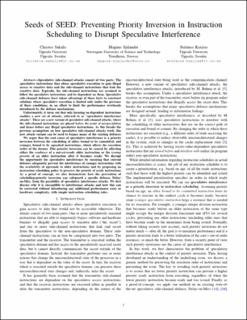| dc.contributor.author | Sakalis, Christos | |
| dc.contributor.author | Själander, Magnus | |
| dc.contributor.author | Kaxiras, Stefanos | |
| dc.date.accessioned | 2022-03-28T14:20:09Z | |
| dc.date.available | 2022-03-28T14:20:09Z | |
| dc.date.created | 2022-01-11T16:38:13Z | |
| dc.date.issued | 2021 | |
| dc.identifier.isbn | 978-1-6654-2025-9 | |
| dc.identifier.uri | https://hdl.handle.net/11250/2988114 | |
| dc.description.abstract | Speculative side-channel attacks consist of two parts: The speculative instructions that abuse speculative execution to gain illegal access to sensitive data and the side-channel instructions that leak the sensitive data. Typically, the side-channel instructions are assumed to follow the speculative instructions and be dependent on them. Speculative side-channel defenses have taken advantage of these facts to construct solutions where speculative execution is limited only under the presence of these conditions, in an effort to limit the performance overheads introduced by the defense mechanisms.Unfortunately, it turns out that only focusing on dependent instructions enables a new set of attacks, referred to as “speculative interference attacks”. These are a new variant of speculative side-channel attacks, where the side-channel instructions are placed before the point of misspeculation and hence before any illegal speculative instructions. As this breaks the previous assumptions on how speculative side-channel attacks work, this new attack variant can be used to bypass many of the existing defenses.We argue that the root cause of speculative interference is a priority inversion between the scheduling of older, bound to be committed, and younger, bound to be squashed instructions, which affects the execution order of the former. This priority inversion can be caused by affecting either the readiness of a not-yet-ready older instruction or the issuing priority of an older instruction after it becomes ready. We disrupt the opportunity for speculative interference by ensuring that current defenses adequately prevent the interference of younger instructions with the availability of operands to older instructions and by proposing an instruction scheduling policy to preserve the priority of ready instructions. As a proof of concept, we also demonstrate how the prevention of scheduling-priority inversion can safeguard a specific defense, Delay-on-Miss, from the possibility ... | en_US |
| dc.language.iso | eng | en_US |
| dc.publisher | Institute of Electrical and Electronics Engineers (IEEE) | en_US |
| dc.relation.ispartof | International Symposium on Secure and Private Execution Environment Design (SEED) | |
| dc.title | Seeds of SEED: Preventing Priority Inversion in Instruction Scheduling to Disrupt Speculative Interference | en_US |
| dc.type | Chapter | en_US |
| dc.description.version | acceptedVersion | en_US |
| dc.rights.holder | © IEEE. Personal use of this material is permitted. Permission from IEEE must be obtained for all other uses, in any current or future media, including reprinting/republishing this material for advertising or promotional purposes, creating new collective works, for resale or redistribution to servers or lists, or reuse of any copyrighted component of this work in other works. | en_US |
| dc.identifier.doi | 10.1109/SEED51797.2021.00022 | |
| dc.identifier.cristin | 1978738 | |
| cristin.ispublished | true | |
| cristin.fulltext | preprint | |
| cristin.qualitycode | 1 | |
